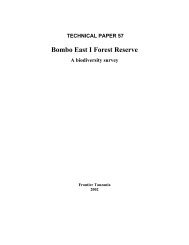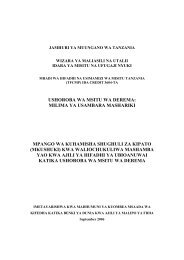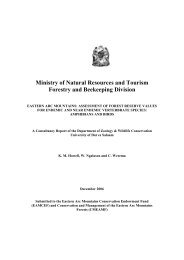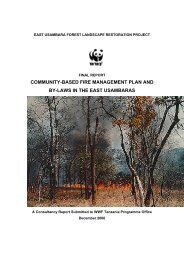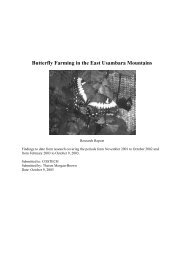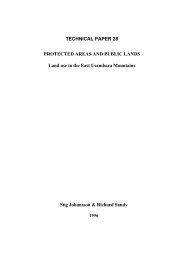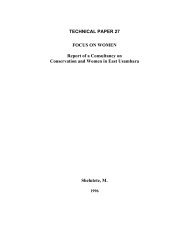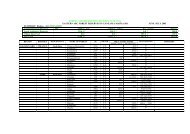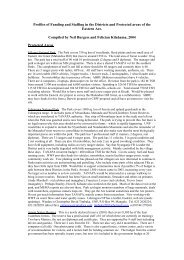Development of Sustainable Forest Use Strategies - Eastern Arc ...
Development of Sustainable Forest Use Strategies - Eastern Arc ...
Development of Sustainable Forest Use Strategies - Eastern Arc ...
You also want an ePaper? Increase the reach of your titles
YUMPU automatically turns print PDFs into web optimized ePapers that Google loves.
in Tanzania, as well as those exotic species that have been introduced in Tanzania,<br />
and that are temporarily maintained in captivity or have become established in the<br />
wild” (MNRT, 1998b:38).<br />
Stated Economic <strong>Use</strong>s<br />
WPT lists game viewing (photographic tourism), tourist (or trophy or sport) hunting,<br />
resident hunting (licensed hunting for meat by residents), ranching, farming and live<br />
animal trade as the recognized forms <strong>of</strong> wildlife utilization allowed in mainland<br />
Tanzania. The Wildlife Division is responsible for issuing hunting and capturing<br />
permits for wildlife occurring in forest reserves (MNRT, 1998b:5). Before holders <strong>of</strong><br />
such permits can legally hunt or capture wild animals in forest reserves they must<br />
seek and obtain entry permits from the Director <strong>of</strong> <strong>Forest</strong>ry and Beekeeping (URT,<br />
2002:1251). The <strong>Forest</strong>ry and Beekeeping Division (FBD) and not the Wildlife<br />
Division (WD) can introduce and conduct game viewing in forest reserves.<br />
Also, WPT permits small-scale animal cropping by rural communities practising<br />
community-based conservation (CBC). Generally, it is understood that CBC is<br />
supposed to be practised on village lands and where possible, on general lands. It is<br />
not known, therefore, if this could be extended to neighbouring forest reserves.<br />
Degree <strong>of</strong> Allowable Economic <strong>Use</strong>s<br />
No specific bag limits are set by WPT for consumptive use <strong>of</strong> wild animals in forest<br />
reserves or anywhere. However, the policy promotes sustainable utilization quotas<br />
on a scientific basis and monitoring <strong>of</strong> wildlife populations that are consumptively<br />
utilized (MNRT, 1998b:22). Also, it exercises control <strong>of</strong> wildlife utilization activities<br />
(p.23). The quotas are set annually per species per specified area (hunting block).<br />
3.1.2.2 Wildlife Conservation Act No. 12 <strong>of</strong> 1974<br />
The main focus <strong>of</strong> the Wildlife Conservation Act No. 12 <strong>of</strong> 1974 (WCA) is on<br />
creation, protection and management <strong>of</strong> game reserves, game controlled areas and<br />
partial game reserves and control <strong>of</strong> use <strong>of</strong> wildlife and other natural resources<br />
therein (URT, 1974). <strong>Forest</strong> reserves are not part <strong>of</strong> these. However, §17 gives<br />
powers to the Minister responsible for wildlife, by order in the government gazette, to<br />
prohibit, restrict or regulate hunting, killing or capture <strong>of</strong> any animal or class <strong>of</strong><br />
animals in any area <strong>of</strong> Tanganyika (mainland Tanzania) in certain periods <strong>of</strong> the<br />
year. Such a period is termed as close season. Currently the close season runs from<br />
January 1 to June 30 and the open (hunting) season is from July 1 to December 31<br />
each year. Also, the Director <strong>of</strong> Wildlife is given powers to kill or authorise the killing<br />
<strong>of</strong> any animal in any place outside national parks and the Ngorongoro Conservation<br />
Area (§52).<br />
12



